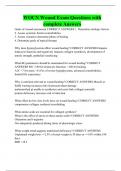WOCN Wound Exam Questions with
complete Answers
Goals of wound assessment CORRECT ANSWERS 1. Determine etiologic factors
2. Assess systemic factors/comorbidities
3. Assess wound to determine phase of healing 4. Determine goals of topical therapy
Why does hyperglycemia affect wound healing? CORRECT ANSWERS Impairs leukocyte function and negatively impacts collagen syntehesis, development of tensile strength, epithelial resurfacing
What BG parameters should be maintained for wound healing? CORRECT ANSWERS BG <180 for leukocyte function; <140 for healing A1C <7 for most, <8 if hx of severe hypoglycemia, advanced comorbidities, limited life expectancy
Why is nutrition relevant to wound healing? CORRECT ANSWERS Muscle or SubQ wasting increases risk of pressure/shear damage
malnourished pt unable to synthesize and cross-link collagen normally protein deficiency increases risk of infection
What effect do low zinc levels have on wound healing? CORRECT ANSWERS compromise collagen synthesis/crosslinking
What amino acids are essential for collagen synthesis? What is the effect of stress on these amino acids? CORRECT ANSWERS Glutamine and l-arginine
Not adequately produced during times of physiologic stress
What weight trend suggests nutritional deficiency? CORRECT ANSWERS Unplanned weight loss =>2.5% of usual weight in 30 days or =>10% within 180 days
BMI <18.5 What serum albumin level indicates malnutrition? CORRECT ANSWERS <3.5 g/dl
What serum transferrin level indicates malnutrition? CORRECT ANSWERS <100mg/dl
What serum prealbumin level indicates malnutrition? CORRECT ANSWERS <19.5
What total lymphocyte count level indicates malnutrition? CORRECT ANSWERS <1500
What are s/s of nutritional deficits? CORRECT ANSWERS skin rashes, cracks in mucous membranes, edema, muscle and subQ tissue wasting, nonhealing wounds, dry/pluckable hair, dry flaky itchy skin
What is the suggested caloric intake? CORRECT ANSWERS 30-35 cal/kg body weight
What is the suggested protein intake? CORRECT ANSWERS 1.25-1.5 g/kg body weight
What is the suggested fluid intake? CORRECT ANSWERS 30ml per kg (unless fluid restriction indicated)
How do you assess perfusion/oxygenation? CORRECT ANSWERS capillary refill,
pulses, presence/absence of edema, TcpO2 levels (at least 40), color of wound bed (bright pink/red), ABI for lower extremity ulcers, systolic bp/episodes of hypotension, vasopressor administration
How do you assess for immunosuppression? CORRECT ANSWERS Comorbidities/therapies such as HIV, steroid tehrapy in doses >30mg/day for >30 days, and/or chemo resulting in neutropenia; high dose NSAIDs What comorbidities compromise wound healing? CORRECT ANSWERS renal failure, liver failure, multisystem trauma, smoking, advanced age
What are the layers of the skin CORRECT ANSWERS Epidermis Basement Membrane Zone
Dermis Subcutaneous Tissue Muscle/Fascia/Bone
What are the layers of the epidermis? CORRECT ANSWERS Stratum corneum - keratinocytes filled with keratin
Stratum lucidum - only in palms/soles, thick areas
Stratum granulosum - odland bodies secrete ceramides, lipophilic
Stratum spinosum - desmosomes (cell to cell junctions) Stratum germinativum - dermal-epidermal junction
What is the Basement Membrane Zone? CORRECT ANSWERS Dermal-
epidermal junction
What are the components of the dermis? CORRECT ANSWERS Papillary dermis: papillae interlock with rete ridges, capillary loops, sensitive to point pressure
Reticular dermis: mostly type 1 collagen, vasculars, and lymphatics
What structures of the skin can regenerate? CORRECT ANSWERS Epidermis and
parts of the dermis
What structures of the skin heal by scar formation? CORRECT ANSWERS Epidermal appendages, Subcutaneous tissue/fascia/muscle
How is newborn skin different? CORRECT ANSWERS No scars up to 2nd trimester
30% thinner skin
Faster epidermal turnover How is premature infant skin different? CORRECT ANSWERS Very thin, increased fluid loss, functional stratum corneum at 30-32 weeks
What problems may arise with infant skin? CORRECT ANSWERS increased permeability, increased MARSI risk, extravasation, diaper dermatitis
How do you mitigate MARSI risk in infants/elderly? CORRECT ANSWERS avoid tape or use hydrocolloid base or silicone adhesive, no alcohol removers only mineral oil, petroleum, silicone (preferred), and citrus)
How do you mitigate extravasation in an infant? CORRECT ANSWERS Hyaluronidase OR phentolamine if vasoconstrictor
How do you mitigate diaper dermatitis? CORRECT ANSWERS Higher pH
Use petroleum base for mild erythema and zinc oxide for denuded skin
sever denudation - carboxymethylcellulose/petrolatum/zinc oxide (Ilex)
What bathing considerations must you take for premature infants? CORRECT ANSWERS <30 weeks bathe with water only for 2 weeks
What are common issues with older skin? CORRECT ANSWERS Thinner, collagen shrinks and causes wrinkles
Rete ridges and dermal papillae flatten - increased risk for tears/stripping
Reduced sebaceous and sweat glands - dry skin
Erratic/decreased melanin production
Decreased sensation - increased trauma risk Loss of SubQ tissue - increased shear and decreased insulation Increased malignant lesions - refer to derm
Reduced blood flow, increased epidermal turnover - slow healing Increased senescense Maybe increased inflammatory mediators, decreased inhibitors
Increased capillary fragility (bruises)




